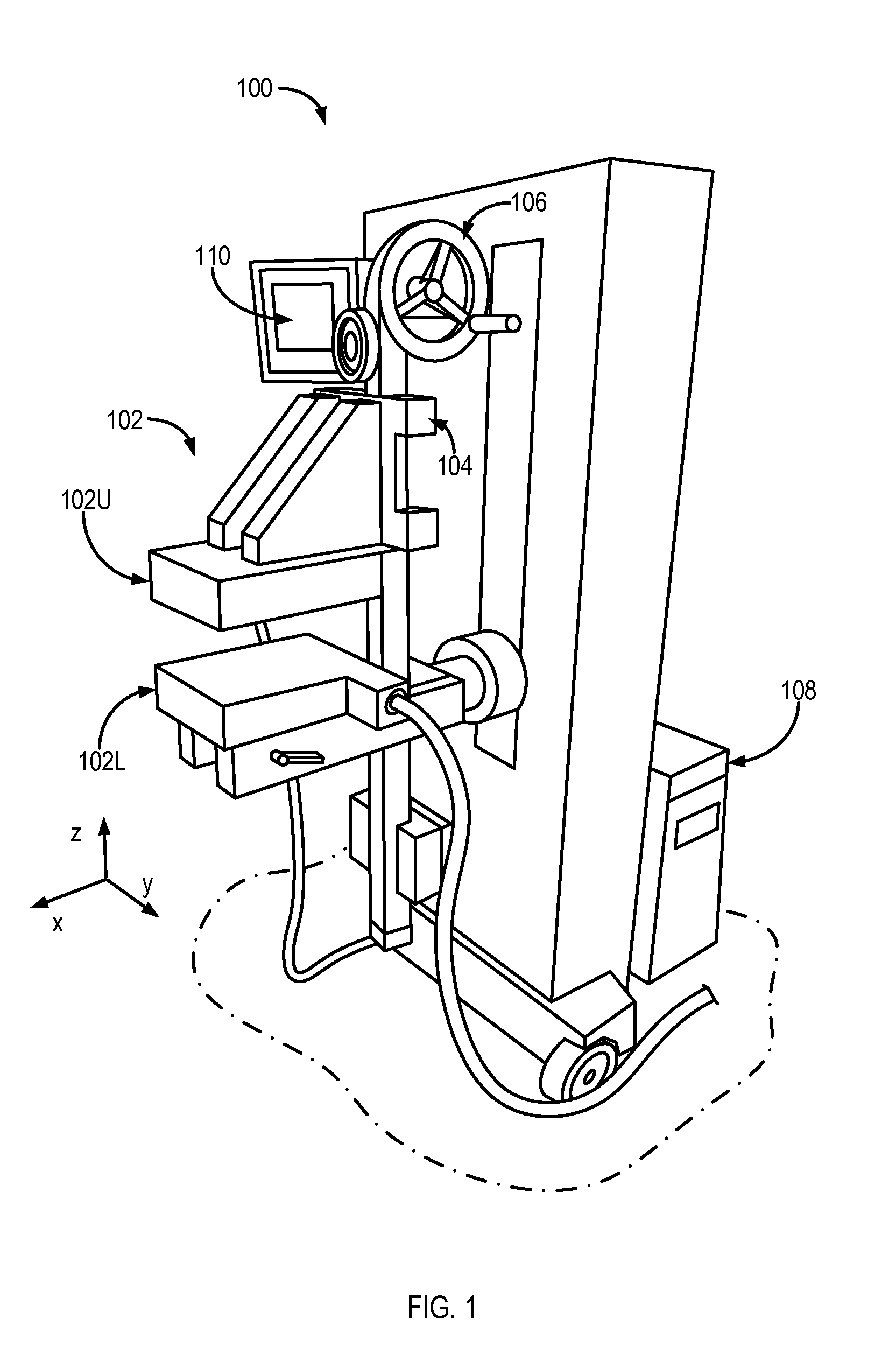Multi-segment slant hole collimator system and method for tumor analysis in radiotracer-guided biopsy
a collimator and multi-segment technology, applied in the field of imaging, can solve the problems of reducing the sensitivity of mammography with the increase of mammographic density, and the less than perfect screening method of mammography
- Summary
- Abstract
- Description
- Claims
- Application Information
AI Technical Summary
Benefits of technology
Problems solved by technology
Method used
Image
Examples
embodiment 204
[0043]In comparison with a traditional collimator that contains a single collimating section, the holes or channels of which are directed substantially perpendicular to the plane of a supporting detector head (for example, to the plane of the head 102L or xy-plane), the embodiment 204 is characterized by an approximately two-fold increased sensitivity and, in addition, permits estimation of the depth of the lesion 226 within the breast tissue 220. As discussed further below, the assessment of lesion depth in the breast 220 is effectuated by considering the relative distances to the lesion as reflected by portions of the image that are respectively associated with the collimating sections 210a, 210b, and 212 of the collimator 204.
[0044]Specifically, and in further reference to FIG. 2, the three-sectional structure of the collimator 204 defines a “dead” or “dark” zone denoted in a cross-sectional view of FIG. 2 as a triangular area 224. The terms “dead” or “dark” refer to the fact tha...
embodiment 300
[0051]In clinical use, the embodiment of the conical slant-hole collimator would be positioned directly underneath the lesion to be biopsied. FIG. 5 shows a portion 500 of the collimator repositioning system containing the embodiment 300 on a tray 504 that is configured to be slidable into a collimator sleeve 508. Lead plates 510 adjacent the collimator 300 on the tray 504 are positioned to limit the field-of-view of the detector (not shown) under the collimator 300 to that corresponding only to an area of the collimator 300. In use, the tray 504 is caused to slide into the sleeve 508 and is positioned beneath the lesion. For lesions located close to the chest wall (within approximately half the diameter of the conical collimator from the chest wall), a semi-circular version of the collimator(containing a left half of the collimator 300 as presented in FIG. 3) would be utilized to gain access to this part of the breast. While possessing only half the sensitivity of the full conical ...
embodiment 100
[0060]Referring again to FIGS. 1, 2 and 4B, imaging of the breast 220 is performed using the aforementioned MBI system embodiment 100 of FIG. 1 that includes, in relevant part, a set-up of FIG. 4A. The results of such imaging which permit a calculation of an in-plane (x and y) location of a lesion in the breast 220 as well as its depth (relative position along the z-axis), and relative uptake of an administered radionuclide. In one embodiment, As illustrated in FIG. 4B and further described below in reference to FIGS. 8 and 9, the upper detector head 102U may be affixed to a rotatable gantry arm, which provides a rotation of the upper detector head 102U (for example, in the xz-plane, about a hinge 222) and facilitates interchangeability of the upper detector head 102U with other functional components devices, such as an ultrasound system, for example.
[0061]In particular, FIG. 8 shows a reconfigurable embodiment 800 of the invention configured to facilitate imaging of breast tissue w...
PUM
 Login to View More
Login to View More Abstract
Description
Claims
Application Information
 Login to View More
Login to View More - R&D
- Intellectual Property
- Life Sciences
- Materials
- Tech Scout
- Unparalleled Data Quality
- Higher Quality Content
- 60% Fewer Hallucinations
Browse by: Latest US Patents, China's latest patents, Technical Efficacy Thesaurus, Application Domain, Technology Topic, Popular Technical Reports.
© 2025 PatSnap. All rights reserved.Legal|Privacy policy|Modern Slavery Act Transparency Statement|Sitemap|About US| Contact US: help@patsnap.com



